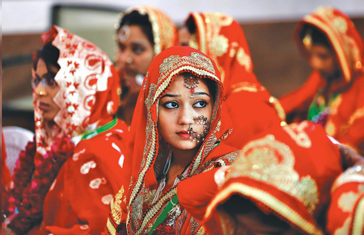Working in Jharkhand, my documentation work takes me to different villages. I saw many young girls holding kids. They were holding those kids not as an elder sister but as young mothers. They become young mothers because they are married at an even younger age.
I kept thinking about 240 million girls when they are wed as children. What are the circumstances under which parents would send their young daughter with a stranger? What are the factors that play a key role in promoting this practice?
So this blog is about both my on ground and off ground research that made me understand more about the problem of early child marriage in India.
To begin with, thepractice of child marriage is rooted in the traditions long followed by the society. In order to prevent adolescent pregnancies, we must first stop blaming girls and start addressing the circumstances that make marriage and motherhood the only option for them. Girls in forced marriages have little say about whether or when they become pregnant. Adolescent birth rates are highest where child marriage is most prevalent, and child marriages are generally more frequent where poverty is extreme. Compared to other age groups, adolescents who are married have both the lowest use of contraception and the highest levels of unmet need also married girls between the ages of 10 and 14 and who are not in school have virtually no access to sex education, further increasing their vulnerability to pregnancy and this is just the beginning.
The issue has much deeper consequences. Child marriage jeopardizes girl’s right, such as the right to education, health, survival and to develop to one’s fullest. It excludes girls from decisions, such as the timing of marriage and choice of spouse. For a girl, marriage usually means an end to her education. It can set aside her chances of getting educated and steal from her life choices. Girls as young as 5 or 6 can be married. It marks a violent and abrupt initiation into sexual relations. Bridegrooms are often older than the girls they marry, and sometimes much older.
Parents of these brides have a big role as girls usually become child brides because their parents give them away for economic or social gain. Families are also motivated by the promise of social approval or increased social standing. Parents think they are upholding tradition, safeguarding the chastity of their girls, and minimizing the risk that their daughters may bear children out of wedlock. In some cultures, child marriage is associated with a religious belief and the need to protect girls from engaging in “improper” or “immoral” behaviour. But the religious justification often masks a family’s desire to protect its honour and reputation. Often parents feel obligated to accept the social norm and they readily give up their daughters to older men. If they fail to give away their daughters, families can be excluded from the community or worse, their daughters or other family members may become the victims of violent attacks. There also are strong economic incentives to give away young children in marriage. The cost of marriage tends to be lower when a child is younger. A young bride leaves her parent’s home and stops using the family’s resources. Grooms and their families usually require a small than-normal dowry for young girls. In cultures where grooms pay for brides, young girls command a higher price than adults.
Working with an organisation (Ekjut) that centrally works around health and nutrition, I was exposed to a number of negative health consequences for the child bride and for the bride’s children. Married girls face life-threatening health consequences. Child brides face a higher rate of contracting HIV and other sexually transmitted infections. Child marriage increases the likelihood that a girl will give birth at a young age and that childbearing will continue uninterrupted throughout reproductive age. Girls under the age of 15 are five times more likely to die in childbirth than women in their 20s and 30s and the ones under 18 face a higher risk of pregnancy-related injuries. A child born to an adolescent mother is twice as likely to die before the age of one, compared to the child of a woman in her 20s and 30s.
Talking to a few of my colleagues who worked with young brides on Gender Based Violence, I also came to know the link between child marriage and the relationship between husband and wife. Girls, who are younger than their husbands and have little education and life experience, usually are in a subordinate role. They have little control over their lives and well-being. This unequal relationship increases the risk that the child bride will be subjected to verbal or physical abuse by her husband, or by her husband’s family. Child brides are more likely to be victims of domestic violence than their peers who marry later they are less likely to participate in politics and community affairs, isolating them in their society.
The more I understood about the issue the more I realised how serious of a problem it is and the urgency with which it needs to be addressed. Ending child marriage can change the lives of girls everywhere and now is the time to act. To end adolescent pregnancies, we must take the focus away from a girl‘sbehaviour and look at the underlying causes of adolescent pregnancy instead, which are gender inequality, poverty, sexual violence, social pressures, negative attitudes and stereotypes about women and girls.
As long as families, communities and governments tolerate child marriage, motherhood in childhood will remain an everyday occurrence in our country. Behaviour change communication can play a major role by channelizing it through Government and Non- Government organisations and addressing the issues to both parent, young women, panchayats, powerful people and decision maker of the villages.
– Ayush Rastogi, IUIF 2017 Fellow
Image Credit: The Indian Express

